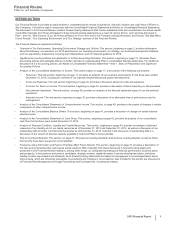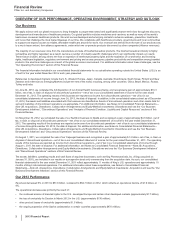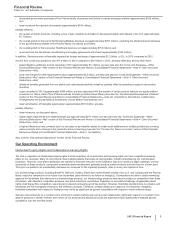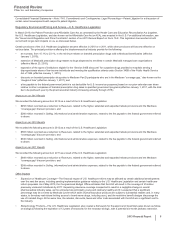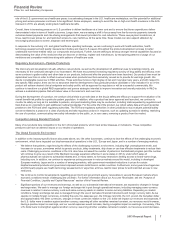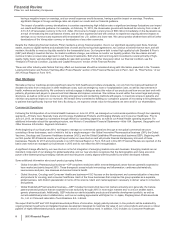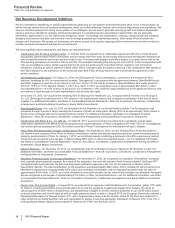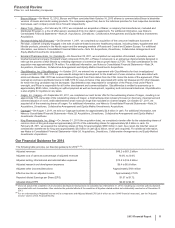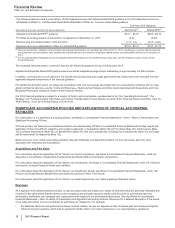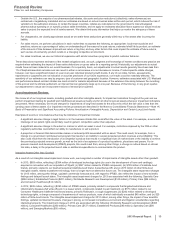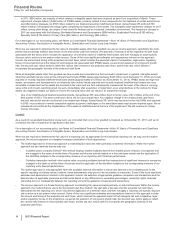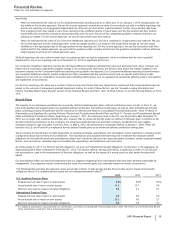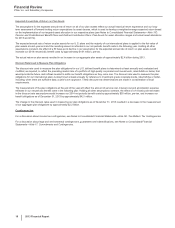Pfizer 2013 Annual Report Download - page 8
Download and view the complete annual report
Please find page 8 of the 2013 Pfizer annual report below. You can navigate through the pages in the report by either clicking on the pages listed below, or by using the keyword search tool below to find specific information within the annual report.
Financial Review
Pfizer Inc. and Subsidiary Companies
2013 Financial Report
7
role of the U.S. government as a healthcare payer, is accelerating changes in the U.S. healthcare marketplace, and the potential for additional
pricing and access pressures continues to be significant. Some employers, seeking to avoid the tax on high-cost health insurance in the ACA
imposed in 2018, are already scaling back healthcare benefits.
Overall, there is increasing pressure on U.S. providers to deliver healthcare at a lower cost and to ensure that those expenditures deliver
demonstrated value in terms of health outcomes. Longer term, we are seeing a shift in focus away from fee-for-service payments towards
outcomes-based payments and risk-sharing arrangements that reward providers for cost reductions. These new payment models can, at
times, lead to lower prices for, and restricted access to, new medicines. At the same time, these models can also expand utilization by
encouraging physicians to screen, diagnose and treat-to-goal.
In response to the evolving U.S. and global healthcare spending landscape, we are continuing to work with health authorities, health
technology assessment and quality measurement bodies and major U.S. payers throughout the product-development process to better
understand how these entities value our compounds and products. Further, we are seeking to develop stronger internal capabilities focused on
demonstrating the value of the medicines that we discover or develop, register and manufacture, by recognizing patterns of usage of our
medicines and competitor medicines along with patterns of healthcare costs.
Regulatory Environment––Pipeline Productivity
The discovery and development of safe, effective new products, as well as the development of additional uses for existing products, are
necessary for the continued strength of our businesses. We have encountered increasing regulatory scrutiny of drug safety and efficacy, even
as we continue to gather safety and other data on our products, before and after the products have been launched. Our product lines must be
replenished over time in order to offset revenue losses when products lose their exclusivity, as well as to provide for earnings growth. We
devote considerable resources to R&D activities. These activities involve a high degree of risk and may take many years, and with respect to
any specific R&D project, there can be no assurance that the development of any particular product candidate or new indication for an in-line
product will achieve desired clinical endpoints and safety profile, will be approved by regulators or will be successful commercially. We
continue to transform our global R&D organization and pursue strategies intended to improve innovation and overall productivity in R&D to
achieve a sustainable pipeline that will deliver value in the near term and over time.
During the development of a product, we conduct clinical trials to provide data on the drug’s safety and efficacy to support the evaluation of its
overall benefit-risk profile for a particular patient population. In addition, after a product has been approved and launched, we continue to
monitor its safety as long as it is available to patients, and post-marketing trials may be conducted, including trials requested by regulators and
trials that we do voluntarily to gain additional medical knowledge. For the entire life of the product, we collect safety data and report potential
problems to the FDA and other regulatory authorities. The FDA and regulatory authorities in other jurisdictions may evaluate potential safety
concerns related to a product or a class of products and take regulatory actions in response, such as updating a product’s labeling, restricting
the use of a product, communicating new safety information to the public, or, in rare cases, removing a product from the market.
Competition Among Branded Products
Many of our products face competition in the form of branded products, which treat similar diseases or indications. These competitive
pressures can have an adverse impact on our results of operations.
The Global Economic Environment
In addition to the industry-specific factors discussed above, we, like other businesses, continue to face the effects of the challenging economic
environment, which have impacted our biopharmaceutical operations in the U.S., Europe and Japan, and in a number of emerging markets.
• We believe that patients, experiencing the effects of the challenging economic environment, including high unemployment levels, and
increases in co-pays, sometimes switch to generic products, delay treatments, skip doses or use less effective treatments to reduce their
costs. Challenging economic conditions in the U.S. also have increased the number of patients in the Medicaid program (and the number
will continue to grow as a result of the Medicaid coverage expansion effective in some states in 2014), under which sales of
pharmaceuticals are subject to substantial rebates and, in many states, to formulary restrictions limiting access to brand-name drugs,
including ours. In addition, we continue to experience pricing pressure in various markets around the world, including in developed
European markets, Japan and in a number of emerging markets, with government-mandated reductions in prices for certain
biopharmaceutical products and government-imposed access restrictions in certain countries. Furthermore, some government agencies
and third-party payers use health technology assessments in ways that, at times, lead to lower prices for and restricted access to new
medicines.
• We continue to monitor developments regarding government and government agency receivables in several European markets where
economic conditions remain challenging and uncertain. For further information about our Accounts Receivable, see the “Analysis of
Financial Condition, Liquidity and Capital Resources” section of this Financial Review.
• Significant portions of our revenues and earnings, as well as our substantial international net assets, are exposed to changes in foreign
exchange rates. We seek to manage our foreign exchange risk in part through operational means, including managing same-currency
revenues in relation to same-currency costs and same-currency assets in relation to same-currency liabilities. Depending on market
conditions, foreign exchange risk also is managed through the use of derivative financial instruments and foreign currency debt. As we
operate in multiple foreign currencies, including the euro, the Japanese yen, the Chinese renminbi, the U.K. pound, the Canadian dollar
and approximately 100 other currencies, changes in those currencies relative to the U.S. dollar will impact our revenues and expenses. If
the U.S. dollar were to weaken against another currency, assuming all other variables remained constant, our revenues would increase,
having a positive impact on earnings, and our overall expenses would increase, having a negative impact on earnings. Conversely, if the
U.S. dollar were to strengthen against another currency, assuming all other variables remained constant, our revenues would decrease,


